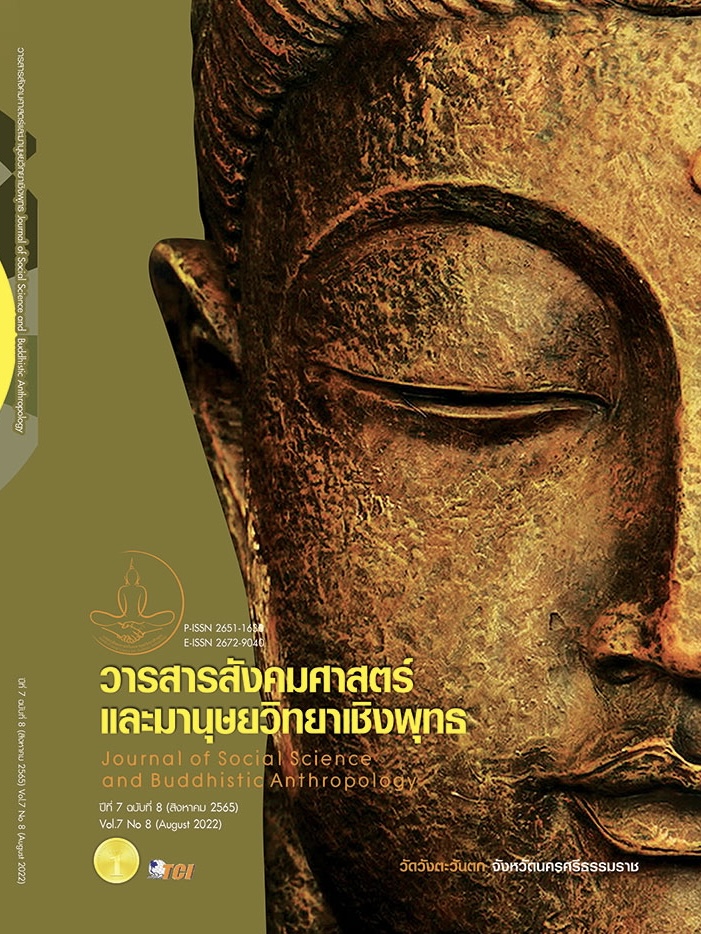DEVELOPMENT OF AN INSTRUCTIONAL MODEL BASED ON EXPERIENTIAL LEARNING AND SOCIOSCIENTIFIC ISSUES APPROACHES TO ENHANCE ENVIRONMENTAL LITERACY FOR LOWER SECONDARY SCHOOL STUDENTS
Keywords:
Instructional Model Development, Experiential Learning Approach, Socioscientific Issues Approach, Environmental Literacy, Lower Secondary School StudentsAbstract
The objective of this research article was to develop an instructional model based on experiential learning and socioscientific issues approaches to enhance environmental literacy for lower secondary school students. This was a research and development. The study procedures were divided into 2 phases; Phase I: studying and analyzing the basic data to develop the instructional model. It consists of studying the related documents and determination of the environmental literacy components. Phase II: constructing and evaluating the instructional model. The sample was 6 experts in research and curriculum development, environmental management, and science education, for examining suitability of tools. The research instrument was the consistency index evaluation form. Data were analyzed by using mean and standard deviations. The results were as follows. The developed instructional model was composed of objective, principles, and six steps as 1) presenting the issues, 2) investigating prior belief, 3) examining evidence, 4) providing scaffolding, 5) reflecting on experiences, and 6) applying to the new situations. The consistency index of the instructional model was 0.95 The instructional model was appropriate at the highest level ( = 4.68) The developed instructional model can be used for enhancing the environmental literacy of the lower secondary school students. It is suggested that individuals interested in the instructional model should study its manual thoroughly to achieve the objectives of the model.
References
ทิศนา แขมมณี. (2560). ศาสตร์การสอน องค์ความรู้เพื่อการจัดกระบวนการเรียนรู้ที่มีประสิทธิภาพ. (พิมพ์ครั้งที่ 21). กรุงเทพมหานคร: สำนักพิมพ์แห่งจุฬาลงกรณ์มหาวิทยาลัย.
วรรณี แกมเกตุ. (2555). วิธีวิทยาการวิจัยทางพฤติกรรมศาสตร์. (พิมพ์ครั้งที่ 3). กรุงเทพมหานคร: สำนักพิมพ์แห่งจุฬาลงกรณ์มหาวิทยาลัย.
สุนีย์ คล้ายนิล และคณะ. (2551). ความรู้และสมรรถนะทางวิทยาศาสตร์ สำหรับโลกวันพรุ่งนี้. เรียกใช้เมื่อ 13 มีนาคม 2565 จาก https://pisathailand.ipst.ac.th/isbn-9789789955918/
สุรีย์พร สายวารีรัตน์ และคณะ. (2560). สภาพปัญหา และแนวทางการปรับปรุงพัฒนาการดำเนินการสิ่งแวดล้อมศึกษาชองโรงเรียนมัธยมศึกษา สังกัดสำนักงานเขตพื้นที่การศึกษามัธยมศึกษา เขต 6. วารสารศึกษาศาสตร์ มหาวิทยาลัยทักษิณ, 17(1), 89-96.
Association for Experiential Education (AEE). (2012). What is experiential education? Retrieved March 13, 2022, from https://www.aee.org/what-is-ee
Barson, J. (1967). Instructional system development a demonstration and evaluation project. Retrieved March 13, 2022, from https://files.eric.ed.gov/fulltext /ED020673.pdf
Bloom, M. & Quebec Fuentes, S. (2019). Experiential learning for enhancing environmental literacy regarding energy: A professional development program for inservice science teachers. Eurasia Journal of Mathematics, Science and Technology Education, 15(6), 1-17.
Burek, K. (2012). The impact of socioscientific issues based curriculum involving environmental outdoor education for fourth grade students. Retrieved March 13, 2022, from https://www.proquest.com/openview/0553abc1b280 ab3edebefb9c13ea8f10/1?pq-origsite=gscholar&cbl=18750
Chu, H. E. et al. (2007). Korean year 3 children’s environmental literacy: A prerequisite for a Korean environmental education curriculum. International Journal of Science Education, 29(6), 731-746.
Daskolia, M. et al. (2012). Secondary Teachers' Conceptions of Creative Thinking within the Context of Environmental Education. International Journal of Environmental and Science Education, 7(2), 269-290.
Febriasari, L. K. & Supriatna, N. (2017). Enhance environmental literacy through problem based learning. Journal of physics: conference series, 012163.
Hollweg, K. S. et al. (2011). Developing a framework for assessing environmental literacy. Washington, DC: North American Association for Environmental Education.
Hungerford, H. R. & Volk, T. L. (1990). Changing learner behavior through environmental education. The Journal of Environmental Education, 21(3), 8-21.
Kinslow, A. T. et al. (2019). Socio-scientific reasoning and environmental literacy in a field-based ecology class. Environmental Education Research, 25(3), 388-410.
Kirkpatrick, J. D. & Kirkpatrick, W. K. (2016). Kirkpatrick's four levels of training evaluation. VA: ATD Press.
Kolb, A. Y. & Kolb, D. A. (2009). Experiential learning theory: A dynamic, holistic approach to management learning, education and development. In Armstrong, S. J. & Fukami, C. V., Eds., The SAGE Handbook of Management Learning, Education and Development. California: SAGE Publications Ltd.
Molinatti, G. et al. (2010). High school students debate the use of embryonic stem cells: The influence of context on decision - making. International Journal of Science Education, 32(16), 2235-2251.
Moroye, C. M. (2005). Common ground: an ecological perspective on teaching and learning. Curriculum and Teaching Dialogue, 7(1.2), 123-137.
Panke, S. (2016). Creative needs assessment in instructional design: selected examples. Retrieved March 13, 2022, from https://www.academia.edu /34957538/Creative_Needs
Roth, C. E. (1992). Environmental literacy: its roots, evolution and directions in the 1990s. Columbus, OH: ERIC Clearinghouse for Science, Mathmatics, and Environmental Education.
Twelker, P. A. (1972). The Systematic Development of Instruction: An Overview and Basic Guide to the Literature. Stanford, CA: ERIC Clearinghouse on Educational Media and Technology, Stanford University.
United Nations Environment Programme, N. (1988). International Strategy for Action in the Field of Environmental Education and Training for the 1990s. Retrieved February 3, 2022, from https://wedocs.unep.org/bitstream/handle/20.500. 11822/33550/ISAFEE.pdf? sequence=1&isAllowed=y
Van der Sluijs, J. P. (2006). Uncertainty, assumptions, and value commitments in the knowledge base of complex
environmental problems. In Pereira, Â. G. et al. (2017). Interfaces between science and society (pp. 64-81). New York: Routledge .
Zeidler, D. L. & Nichols, B. H. (2009). Socioscientific issues: Theory and practice. Journal of elementary science education, 21(2), 49-58.
Zo'bi, A. S. (2014). The Effect of Using Socio-Scientific Issues Approach in Teaching Environmental Issues on Improving the Students' Ability of Making Appropriate Decisions towards These Issues. International Education Studies, 7(8), 113-123.
Downloads
Published
How to Cite
Issue
Section
License
Copyright (c) 2022 Journal of Social Science and Buddhistic Anthropology

This work is licensed under a Creative Commons Attribution-NonCommercial-NoDerivatives 4.0 International License.








